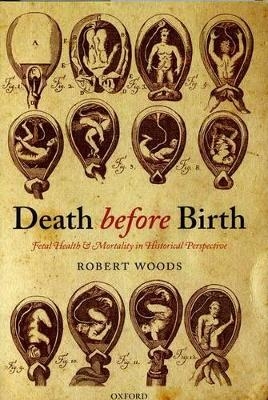
Death before Birth
Fetal Health and Mortality in Historical Perspective
Seiten
2009
Oxford University Press (Verlag)
978-0-19-954275-8 (ISBN)
Oxford University Press (Verlag)
978-0-19-954275-8 (ISBN)
A study of fetal health from the seventeenth century to the present day (focusing principally upon European and North American populations), this is the first book to offer a historical perspective on the subject and to combine both medical history and demographic research, using long-term and comparative perspectives.
Considering its importance, the history of fetal health and mortality remains a neglected area. Medical historians have tended to focus on maternal mortality and professional conflicts between midwives rather than on the unborn, while among the social scientists demographers and epidemiologists have until recently devoted most of their attention to infants and children.
Death before Birth redresses this imbalance, redirecting attention to the fetus. A study of fetal health from the seventeenth century to the present day, it is the first book to offer an historical perspective on the subject and to combine both medical history and epidemiological and demographic research, using long-term and comparative perspectives, including a strong international comparative element, across both Europe and North America. The book not only provides an account of how fetal health and the risks facing the unborn (miscarriages, abortions, stillbirths etc) have changed, it also offers an interpretation of the causes, one that focuses on the role of obstetrics and the epidemiology of maternal infections.
Along the way, it pays detailed attention to a host of related themes, such as varying cultural practices in the recognition of stillbirths; the age pattern of mortality risk between conception and live birth; comparative trends in late-fetal mortality and their causes; fetal mortality and obstetric care during the eighteenth, nineteenth, and twentieth centuries; and the contrasting approaches of the pathologists and 'social epidemiologists' to the causes of fetal death. The book concludes with a study of the 'fetus as patient', focusing on issues surrounding the legalization of abortion in many Western countries and the public health challenges of persistently high mortality in less developed countries.
Considering its importance, the history of fetal health and mortality remains a neglected area. Medical historians have tended to focus on maternal mortality and professional conflicts between midwives rather than on the unborn, while among the social scientists demographers and epidemiologists have until recently devoted most of their attention to infants and children.
Death before Birth redresses this imbalance, redirecting attention to the fetus. A study of fetal health from the seventeenth century to the present day, it is the first book to offer an historical perspective on the subject and to combine both medical history and epidemiological and demographic research, using long-term and comparative perspectives, including a strong international comparative element, across both Europe and North America. The book not only provides an account of how fetal health and the risks facing the unborn (miscarriages, abortions, stillbirths etc) have changed, it also offers an interpretation of the causes, one that focuses on the role of obstetrics and the epidemiology of maternal infections.
Along the way, it pays detailed attention to a host of related themes, such as varying cultural practices in the recognition of stillbirths; the age pattern of mortality risk between conception and live birth; comparative trends in late-fetal mortality and their causes; fetal mortality and obstetric care during the eighteenth, nineteenth, and twentieth centuries; and the contrasting approaches of the pathologists and 'social epidemiologists' to the causes of fetal death. The book concludes with a study of the 'fetus as patient', focusing on issues surrounding the legalization of abortion in many Western countries and the public health challenges of persistently high mortality in less developed countries.
Robert Woods was John Rankin Professor of Geography at the University of Liverpool. He was the author of The Demography of Victorian England and Wales (2000) and Children Remembered: Responses to Untimely Death in the Past (2006). He edited the journal Population Studies and was a Fellow of the British Academy.
Preface ; 1. Introduction to fetal health and mortality ; 2. Definitions, measurement, influences ; 3. The prospects for survival from conception to childhood ; 4. Fetal mortality in comparative perspective ; 5. Midwifery and fetal death ; 6. Fetal pathology and social obstetrics ; 7. Arguments from medical history and demography ; 8. Induced abortion and the fetus as patient: a continuing paradox ; Bibliography ; Index
| Erscheint lt. Verlag | 1.10.2009 |
|---|---|
| Zusatzinfo | 5 black and white halftones, 37 figures |
| Verlagsort | Oxford |
| Sprache | englisch |
| Maße | 163 x 242 mm |
| Gewicht | 628 g |
| Themenwelt | Medizin / Pharmazie ► Gesundheitsfachberufe ► Hebamme / Entbindungspfleger |
| Naturwissenschaften ► Geowissenschaften ► Geografie / Kartografie | |
| Sozialwissenschaften ► Soziologie ► Empirische Sozialforschung | |
| ISBN-10 | 0-19-954275-9 / 0199542759 |
| ISBN-13 | 978-0-19-954275-8 / 9780199542758 |
| Zustand | Neuware |
| Haben Sie eine Frage zum Produkt? |
Mehr entdecken
aus dem Bereich
aus dem Bereich
Evidenz und Erfahrung
Buch | Softcover (2024)
Springer (Verlag)
49,99 €
eine Arbeitshilfe für Hebammen im Praxisalltag
Buch | Softcover (2023)
Kohlhammer (Verlag)
42,00 €
Buch | Softcover (2023)
Urban & Fischer in Elsevier (Verlag)
36,00 €


